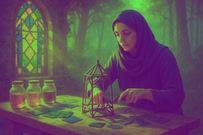Introduction
Beneath a sky that warmed to gold each evening over the great rivers and stone temples of ancient Cambodia, a single event was said to change the fortunes of a people: the birth of twin princes whose names would be spoken by paddlers on the Tonle Sap and by monks within the cool shade of sandstone galleries. In a kingdom of slow-moving water and slow-moving seasons, two infants arrived at the same hour, and with them came a promise and a danger. The midwives whispered of auspicious signs—lotus blossoms drifting into the palace moat, a flock of white ibis circling above, and a soft wind carrying the scent of palm sugar and frangipani. Yet joy rarely arrives without its shadow. A jealous spirit or a scheming courtier—some say a woman of power who feared the change twins might bring—set a chain of events into motion. By dawn, the palace gates had seen hurried hands and secret passages, and before the sun could climb fully, the two infants had been separated and placed into the hands of strangers. What followed were twin lives pulled apart like threads from the same cloth. One child would grow with the river in his blood, learning the language of fish and storm; the other would be raised among temple bells and carved lintels, learning to read the proverbs of the elders. Their stories would carry them through longboats and marketplaces, through bargains with spirits and clashes with bandits, through vows and betrayals. This is the tale of Vorvong and Sorvong—how two brothers, born under the same auspicious moon, were tested by misfortune and shaped by kindness, until the day endurance and memory braided their lives together once more.
Part One: Of Rivers and Temples — The Diverging Paths
The story that was told in villages and at the feet of monks began with confusion and quick thinking. After the two infants were taken from the palace in the night, one child found refuge in the nets of a humble fisherman who lived where the river widened into a lake. He named the boy Vorvong, which in those tales later tongues would say meant “one who learns the river.” The fisherman was a patient man who taught the child to watch the clouds and read the way the water bowed to the wind. Vorvong grew lithe, his hands callused by oars and ropes, his eyes learning the sun’s slow passage across water. He learned to mend nets with the same careful motions his foster father used to repair the teak canoe. In early mornings, when mist still stitched the river to shore, Vorvong would catch stories from traders who came with baskets of salt and spices — stories of distant pagodas, of stone faces carved on temple towers, and of a royal line whose name was often whispered. These names lodged in the child’s curiosity like seeds.

Sorvong’s life took another pattern. He was found at the stair of a temple where a novice monk discovered him swaddled among flowers left for the shrines. The monk took him in, and the child grew learning the rhythm of bell and chant. Sorvong learned to trace the flowing script and to carve small figures from wood. His hands learned the slow patience of artistry—the same patience that the makers of bas-relief had when shaping stories into stone. Within the temple’s cool corridors he learned not only to read the words of the sacred texts but also to listen for the lessons of life whispered between their lines. He learned of duty and sacrifice, and his heart filled with both compassion and a deep, abiding restlessness that asked, What lies beyond the temple gate?
Both boys grew with a kind of hunger that would not be appeased by routine. Vorvong’s curiosity led him to the markets that fringed the water, where traders bartered rice, silks, and news from provinces beyond the mountains. He became acquainted with the river people—boatwrights, fishermen, toddy-tappers—whose laughter and argument shaped his sense of justice. He developed a knack for negotiation and for finding what was lost: a chest, a stray goat, a mislaid memory. Sorvong, sheltered by incense smoke and the measured footsteps of novices, studied the old inscriptions carved into temple lintels. He learned to spot a missing stone and to repair a broken story. Yet the temple could not keep him. In dreams, he seemed to see figures by water, faces that felt like home. He began, in secret, to make small drawings of boats and barnacled poles, the strokes of his charcoal always finding the river’s curve.
Their adventures were shaped by the landscapes of Cambodia. Vorvong’s greatest early test was a flood season. That year the river rose with an angry speed, swallowing fields and making the village tremble. Houses held between the trunks of trees became islands that needed rescue. Vorvong, with a handful of other men, cut through the dark water to carry children and bundles to the high ground. In one fierce night, he found a woman whose house had collapsed under water and, with no thought for his own safety, dove back to pull free an elderly man trapped beneath beams. The villagers called him brave for months afterward, but Vorvong remembered only the feel of the river’s teeth and the gratitude that warmed his hands. It was in such moments that rumor found him—whispers that a child of noble blood might live among the river folk.
Sorvong’s tests were quieter but not less perilous. A band of roving men once threatened the temple, seeking to plunder relics and intimidate the residents. Sorvong organized the novices, using the shelter of the library and the labyrinth of corridors to hide the elders and create distractions. He negotiated with a group of traveling performers, convincing them to stay the night and create a ruckus to unnerve the thieves. When dawn came, the thieves, disoriented and frightened by the sudden noise and the sheer stubbornness of the temple’s defenders, slipped away. The prioress later praised Sorvong’s cleverness. He, however, kept thinking about the faces of the fleeing men and about how little it took to tip a small community into disaster. Both boys learned, in their own ways, that courage is braided with compassion, and that protecting others often cost more than you could account for in coins.
Along their roads they encountered spirits—neak ta, guardian beings of land and river—who tested their humility. An old woman who was more than she seemed asked Vorvong for help in carrying a heavy pot; he carried it willingly and later found the pot turned into a vessel that sang with a voice guiding him to an abandoned boat full of rice. Sorvong once tended a wounded bird and in return was given a feather that, when kept beneath his pillow, led him in dreams to a hidden path where his family’s emblem lay carved into a mossy stone. These episodes planted memory-sparks in each boy: hints that their origins were not ordinary. Yet the puzzle pieces refused to fit. Each discovery seemed to point toward a royal past, but never wholly revealed it.
Their journeys also brought them companions. Vorvong befriended a young woman named Dara who sold baskets in the market and who had a laugh like wind through palm leaves. Dara taught him the finer points of repair and counselled him when his temper flared. Sorvong’s friend was a temple sculptor named Kanika, whose steady hands and gentle jokes soothed Sorvong's urgent questions. Each companion became integral to the progress of their lives—Dara with her sharp eyes and loyalty, Kanika with her quiet knowledge and fierce protection. Through them, Vorvong and Sorvong learned that family could be formed by choice as well as by blood.
As they moved toward adulthood, both princes—unknown to themselves—felt the tug of events larger than any single man. A drought threatened the paddies one year; a distant war looked like it might sweep across the plains another. Both men answered the calls in ways their upbringings determined. Vorvong, with his river-honed resilience, was quick to rally improvised rescue parties when water turned traitor or to broker water-rights disputes in ways that respected both small farmers and traveling merchants. Sorvong, with his temple-born patience, became a mediator when disputes over land and rites erupted, reminding kings and peasants alike that custom served the living only when it served justice. Through a dozen episodes—some joyous, some sorrowful—each step eased the knot of questions toward a single point: the suspicion that a lost lineage waited to be found.
Stories of the two men—brave, clever, strange in their congruence—spread like a sweet, persistent incense. Certain motifs resurfaced in provincial songs: two brothers separated, two paths converging like tributaries, a hidden emblem, the recurring image of a lotus cut in half. In markets, children would rework their games around these motifs, pretending to be one sibling or the other, building tiny temples from clay, steering toy boats made from banana leaves. Little did they know how closely the play mirrored fate. For fate, in Cambodian lore, rarely rushes; it works like the slow erosion of stone, shaping truth until it is revealed. What the next seasons would bring was beyond their predictions—but there remained the certainty that both men, formed by hardship and grace, were being prepared for something neither could imagine alone.
Part Two: Trials, Tests, and the Woven Knot
Years in Cambodia move like seasons with their own logic, and by the time both men reached the full measure of their youth, tales of their deeds had embroidered themselves into local lore. It was inevitable then that their paths would begin to braid. The first formal test that foreshadowed reunion came in the form of a drought that lasted beyond reason. Crops failed, and the courts of the neighboring provinces proposed to levy heavy taxes on those who still had grain. When the envoy carrying the king’s decree reached the villagers by Vorvong’s river, they expected submission; instead they found a man who insisted on negotiation. Vorvong argued for a moratorium, citing the poor and the displaced, and when the envoy refused, he organized the river people to carry what little rice remained across provinces, distributing aid, stealing quietly if need be from stores that greed had fattened. His clever raids were more like acts of justice; he always targeted hoarders and gave to those who could not repay him. Word of his actions reached the royal court, not as theft but as shadow justice, the kind that made rulers both admire and fear.

Sorvong’s tests, encountered in a different season, were no less dramatic. A politician of the court, sensing unrest and seeking to consolidate power, alleged that sacred relics had been stolen from a provincial shrine and demanded a public investigation. The people whispered that the politician sought a pretext to install his men among the temple ranks. Sorvong stepped forward in mediation, and his quiet, unshakable demeanor won the trust of frightened villagers. He traveled to the disputed shrine, traced footsteps in a courtyard that had seen both footfall and blood, and discovered—hidden beneath a floor tile—a seal carved with a royal emblem that matched the design he had once seen in his dream. The seal led him to an elderly woman who, at last, confessed to having sheltered a child for a night during a storm years before. Her description was startlingly like a fragment of his own memory: a birthmark shaped like a curled lotus behind the left ear. Sorvong’s pulse quickened. If the seal and the mark were true, then something larger than theft lurked: a hidden lineage, a lost birthright.
Those two threads—the river’s defiance and the temple’s discovery—unwound across the same months and pushed the two men into action. They neither knew of the other’s existence, but both were being escorted by destiny toward the same orbit. They were about to be tested by men and spirits and by the very human flaws of jealousy and pride. A powerful lord, a merchant-turned-warlord, found his hold on the region slipping as people rallied to support the two heroes. He devised a plan that was part trap, part spectacle. Announcing a grand festival of masks and puppets—an event that would draw crowds from provinces near and far—he intended to expose and humiliate those he considered troublemakers before the assembled lords. The festival would culminate in a contest of skill, and the prizes were to be both wealth and notoriety.
Vorvong arrived at the festival with a small flotilla, his boat painted in bold swaths of lacquer. He came to trade, to see the dance, and to look for bargains, but the lord’s men recognized him from whispered reports and tried to detain him. Vorvong, with swift charm and a willingness to risk his own safety for others, freed a group of accomplices who had been seized for unpaid debts. The crowd roared; sometimes courage inflames crowds in unpredictable ways. Sorvong, also present though arriving by a dusty road from another province, stood on flagstone and watched the riverfolk defend their own. He offered wise counsel on how to calm tensions, recommending that the lord stage a mock contest that celebrated common life rather than oppressive spectacle. The lord, wanting applause more than justice, agreed but kept his trap intact.
Then the test became both intimate and grand: a competition of strength, wit, and art. Representatives from the market, the temple, and the river were called to perform. Vorvong’s team built a raft and navigated a treacherous slalom between bamboo markers, hauling sacks of rice while singing work-songs to synchronize their pull. Sorvong, as a leader of temple youth, choreographed a ritual dance involving carved masks that told the story of a king who learned humility through loss. The performances were striking and unexpected, and the crowd cheered until the evening lights—lamps strung like constellations—flickered across the water. Yet the lord’s men were not finished: as the winners were to be declared, a brawl erupted, calculated and brutal. Men who had been promised rewards now turned on one another when coin and prestige were threatened. In the chaos, a ring of bronze came loose and struck a man whose identity no one recognized. The man’s features—though water-streaked and hidden—bore a scar that someone in the crowd whispered was the same mark as the seal found by Sorvong. It was a revelation that sent shockwaves. The lord’s plot had inadvertently pried open a secret.
Pursuit and uncovering followed. The man with the scar, when questioned, recounted a story about a night years before when he had hidden two infants to save them from political retribution. His tale matched the whisper of old conspiracies in the royal household. As rumors spread through the jam-packed festival—through stalls that sold grilled fish and candied tamarind, through laughter and the deeper, quieter conversations of those who watched from temple balconies—the two men were drawn closer. They still did not know one another, but they were recognized as connected in the gossip of courtyards and on the breath of river breathers.
The subsequent days were a mosaic of small discoveries and sharp reckonings. A woman who remembered the midwife’s clay bead—one of two beads threaded on a string to identify royal births—produced it at a market when she saw a child’s carving in Sorvong’s workshop. Vorvong found a carved motif on a ship mast that matched the carved motif on a temple banner Sorvong had been restoring. Each fragment fit like a shard of pottery into a larger pot. The men, now aware of the possibility of shared blood, were reluctant to claim it; both had learned to view authority with suspicion. But the villagers, the monks, and the river folk pressed for answers. They insisted the truth be sought not through violence but through recognition of lineage—through rituals and memory
A trial by ritual was arranged at a small, informal council in a temple courtyard. The elders asked that both men come forward and place their hands upon the same carved stone, an ancient piece of sandstone said to reveal the truth to those who approached with pure hearts. When Vorvong and Sorvong did so, the priest who had tended to their tentative inquiry recited verses that described the night of their separation: the wind, the lotus, the hush of a palace corridor. He then asked each to tell of their earliest memory. Vorvong spoke of a lullaby heard only once at dawn and the feel of a small hand in his. Sorvong described the smell of incense and a cotton cloth with a stitch in the corner shaped like a lotus. As words filled the courtyard, villagers leaned forward, and the two men found themselves seeing, through the eyes of others, the same patched garment, the same whisper of name. A hush fell, and time stretched like warm cloth between palms.
Reunion seldom arrives in the clean lines of certainty. Instead, it is messy. The temple priest—who had once been a court advisor—produced a necklace worn by royal infants, sealed with a symbol that matched the one Sorvong had seen and the maritime motif Vorvong had found. When the necklace was placed before them, both men reached simultaneously, and in their hands the metal seemed to hum. They did not immediately leap to embrace; they were men who had been forged by hardship and suspicion. Yet in their eyes there was an undeniable recognition: the angles of cheekbones, the tilt of a smile, an old, private cadence of breath. Tears came, not the theatrical kind seen at festivals, but quiet tears that carried the salt of the river and the smoke of temple lamps.
That night, the villages celebrated cautiously. The lord who had set the traps felt the ground shift beneath him; his alliances were threatened, and his attempts to reclaim face grew desperate. He recruited mercenaries, spread rumors of imposture, and tried to buy loyalty. But loyalty proved brittle when weighed against the simple truth. People preferred the men who had proven faithful in times of flood and fear. When forces were finally arrayed, it was not merely a clash of swords but a contest of will and community. Vorvong and Sorvong, newly aware of one another’s existence and of the depth of their shared past, stood not as rivals but as allies. They marshaled boats, sculptors, basket-makers, monks, and market women. The lord had wealth, but the men who came to support the princes carried with them a public memory and a stubborn devotion far older than any treasury.
In the battle that followed, strategy mattered more than numbers. Vorvong led river raids that cut off supplies; Sorvong organized a network of signals from temple towers, using fire and lantern to coordinate movement across flatlands. The final confrontation was not bloody in the epic sense—the people preferred to reclaim their peace rather than to spill kin blood—but it was decisive. The lord’s men, seeing their fellows abandon them in favor of community and conscience, surrendered. The lord himself fled into the night and was later taken in by the law of the land; some say he found redemption, others that he simply vanished. What remained was a kingdom slowly realigning itself to a moral gravity that had long been out of balance.
In the weeks after, the brothers learned about the life they might have shared. The palace elders, shamed by their earlier secrecy, opened dusty records and told how a frightened attempt to secure the succession had led to the infant separation. The full truth, when finally told, arrived gentler than rumor had expected. It was a story of fear that had become habit, of a court that had misread signs and acted in haste. Vorvong and Sorvong, listening, felt grief for the lost years and something else—an odd relief as if missing pages of a book had at last been found. Together they decided to rebuild what had been broken not by reviving old privilege but by reshaping ties between palace and people. They argued for reforms: appointment of elders to oversee land distribution, charitable programs for flood relief, and the restoration of neglected shrines. They worked not to reclaim a throne for themselves but to create a community that would not allow such a division of fortune again. Their rule—when they finally accepted roles of stewardship—was marked by a humility born from hardship and by an insistence that leadership answers to the common good.
And though this is a tale of trials and cleverness, it is also one of small mercies: the woman who had sheltered the infants was forgiven and recognized; a merchant who had once hoarded excess grain helped build a new granary for lean seasons; and the lord who had tried to entrap them later became a figure of caution, a reminder that fear can make men cruel. The princes themselves found in one another what each had lacked: Vorvong offered Sorvong a taste for immediacy and laughter in marketplaces; Sorvong gave Vorvong a sense of long view, the ability to sit and listen to an elder’s complaint without hurrying to fix it. Their companionship was a weaving of river skill and temple patience, braided now with the practicalities of governance and the warmth of shared meals at dusk. The people told their story in new songs—songs about two brothers who had gone missing like the moon behind a cloud and had returned like tide, bringing water for the paddy and light for the shrine. These songs traveled downstream and upstream and into the halls of other rulers, where minstrels would hum the chorus for years.
The legend thus moved beyond the specifics of who had done what and became, instead, a lesson that many told to their children: that perseverance, coupled with compassion, shapes a life; that truth will eventually unroll itself like a scroll; and that those who govern must remember the faces of those they serve. In every telling, the river and the temple remained central images, because Cambodia itself had always been a place where water and stone coexisted in a patient tension. Vorvong and Sorvong, born of the same night and shaped in different schools of endurance, became symbols for how difference can be turned into kinship and how a people can repair itself when its members are willing to act with humility.
Conclusion
The Legend of Vorvong and Sorvong endured because it belonged to the landscape: a tale shaped by slow rivers, patient stone, and people who measured seasons in harvests and holy days. In the end, the two brothers did more than reclaim a name; they taught a kingdom how to hold together. They showed that perseverance is not merely stubborn endurance but the steady work of rebuilding trust, and that the heart of leadership is service. In villages, people still point to carved lintels and broken beads and tell the children how the river taught one prince to move with its tides while the temple taught the other to listen to the world’s softer rhythms. The moral is not wrapped in a single pronouncement but in a thousand small acts: mending a net for a neighbor, sharing grain in a lean season, or standing up for truth when it is easier to look away. The brothers’ lives became a living repository of such acts. When storytellers weave their version, they remind the listener of the bond between place and people, and of the simple idea that even when lives are pulled apart by fear or greed, courage and compassion can reknit them. That is why the tale is told—so that new generations will learn that the measure of a person, and of a nation, is not in its wealth or its power but in its willingness to endure, forgive, and to make whole what has been broken.

















